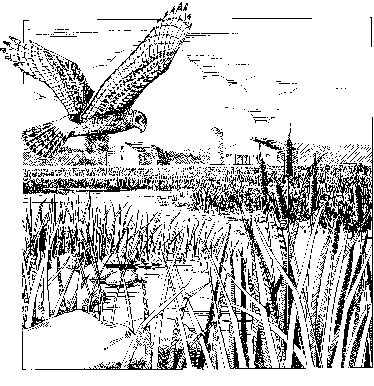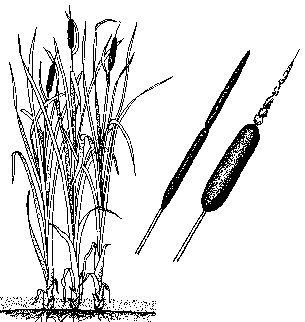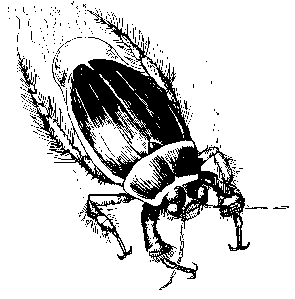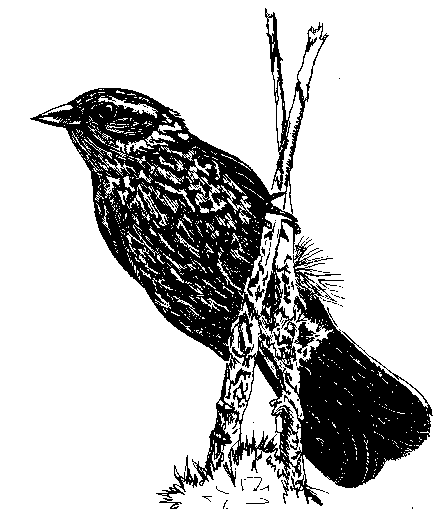
Eastern Habitat Joint Venture
 Like slender signposts, the brown flowering heads of cattails proclaim the presence of marsh habitat. Whether it is thousands of acres in size or just a tiny pocket tucked by the roadside, a marsh is brimming with plants and animals. Many species of wildlife spend part or all of their lives in marshes. Marshes are important wildlife habitat. Marshes also are essential to the health of the environment.
Like slender signposts, the brown flowering heads of cattails proclaim the presence of marsh habitat. Whether it is thousands of acres in size or just a tiny pocket tucked by the roadside, a marsh is brimming with plants and animals. Many species of wildlife spend part or all of their lives in marshes. Marshes are important wildlife habitat. Marshes also are essential to the health of the environment.
Description
A freshwater marsh is a nutrient-rich wetland that normally is covered with water throughout the year. Marshes tend to have a mix of lush aquatic plants and open water, and be bordered by shrubs and grasses. Often marshes develop on the edge of ponds and lakes or along the sides of streams and rivers. In fact, many marshes are actually old beaver ponds or shallow lakes that have become in-filled over time.
There are two general classes of marsh: deep marsh and shallow marsh. Deep marshes have water depths averaging between 15 - 90 cm during summer. The most conspicuous types of plants in a deep marsh are emergents - plants that stand above the water's surface. Floating plants and submergent (underwater) plants also occur in deep marshes. Shallow marshes average less than 15 cm in depth during summer and are usually covered with emergent plants.
Cattail  |
Water levels in a marsh can fluctuate. By late summer sections of some marshes dry out and become overgrown with vegetation. However, despite how dry the surface of a marsh may appear, water normally remains within the rooting zone of plants for most of the growing season.
Wildlife of freshwater marshes
Marshes are one of the most biologically productive types of wetland. Seasonal flooding continually adds nutrient-rich water and sediments to marshes. These nutrients nourish plants which, in turn, attract other wildlife. It is estimated that in terms of plant production, marshes are three times as productive as agricultural land and four times as productive as lakes and streams.
Marshes are busy places, full of wildlife and activity. Some of the most striking sights in a marsh are the dense stands of grass-like rushes and cattails. Other emergent plants characteristic of marshes include arrowheads, reeds and sedges. Common floating and underwater plants include waterlily, duckweed, pondweed and bladderwort.
The lush vegetation of marshes provides protection and food for countless numbers of creatures. Marshes attract a wide variety of animals, ranging from deer to diving beetles. These wetlands provide prime breeding and rearing habitat for many species of waterfowl and marshbirds, such as the black duck and pied-billed grebe. Songbirds, like the red-winged blackbird, nest in marshes and feed extensively on mosquitoes, midges, dragonflies and other marsh residents.
Predacious diving beetle  |
Many amphibians rely on marshes for breeding habitat. In spring, several species of frog and salamander migrate by the thousands from their forest homes to wet areas, like marshes, to mate and lay their eggs. The young hatch and mature in marshes before returning to land as adults.
Aquatic mammals living in marshes in Nova Scotia include muskrat, otter and beaver. Interestingly, dams constructed by beaver are responsible for creating many of the province's wetland habitats.
Role of freshwater marshes
In addition to being extremely productive habitat for wildlife, marshes, like all wetlands, help maintain the health of our environment.
People are beginning to realize how effectively marshes naturally breakdown wastes and remove contaminants that might otherwise have polluted the water supply. Right now, in an effort to mimic nature's ways, several towns are using existing marshes or 'designing' marshes to purify and recycle their raw sewage. And the idea is spreading!
Conservation
Obviously marshes are busy places: they produce food for wildlife and people; provide habitat for wildlife; attract curious outdoor hikers and canoeists; serve as fascinating outdoor classrooms and help maintain the environment. Unfortunately, many marshes have disappeared from Nova Scotia's landscape.
In the past, many larger marshes were ditched, drained and converted to agricultural land because of their nutrient-rich soil. Today, some people still consider marshes as unsightly bug-infested places. Consequently, many small marshes are in-filled to make room for development.
Helping marshes...
|
Luckily, marshes are gaining respect as being important and productive pieces of our environment. Nature walks and classroom visits to local marshes are now eagerly anticipated events. Ongoing efforts to conserve marshland habitats are helping to keep these bustling places alive and well.
Female red-winged blackbird  |
 |
 |